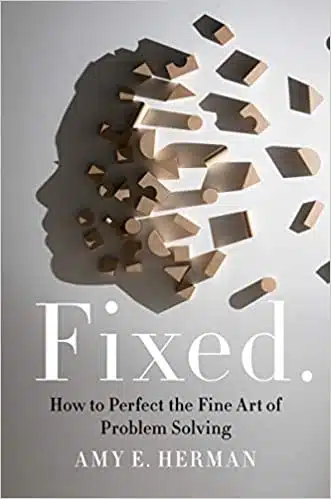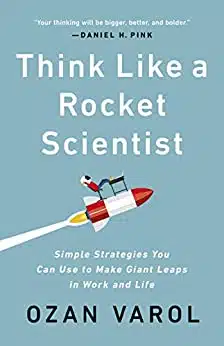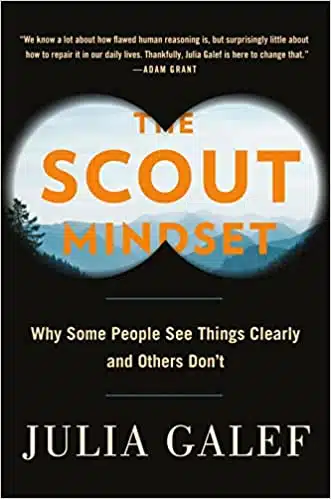You found our list of top problem solving books.
Problem solving books are guides that improve critical thinking capability and the ability to resolve issues in the workplace. These works cover topics like bias and logical fallacies, problem prevention, and prioritizing. The purpose of these books is to help workers remain calm under pressure and come up with solutions more quickly.
These guides are similar to decision making books, negotiation books, and conflict resolution books. To improve competency in this area, one can also play problem solving games.
This list includes:
- problem solving books for adults
- creative problem solving books
- business problem solving books
- problem solving books for programmers
Here we go!
List of problem solving books
Here is a list of books to improve problem solving skills in the workplace.
1. Fixed: How to Perfect the Fine Art of Problem Solving by Amy E Herman

Fixed is one of the most useful new books on problem solving. The book calls for problem solvers to look beyond instinctual and obvious answers and provides a framework for more creative thinking. While most folks think about problem solving in terms of logic, reason, and disciplines like math and science, this book shows the role that art and imagination play in the process. Amy Herman consulted on leadership training with Silicon Valley companies and military organizations and brings this expertise into the text to train readers on how to adopt a more innovative critical thinking approach.
Notable Quote: “Working through problems is critical for productivity, profit, and peace. Our problem-solving skills, however, have been short-circuited by our complicated, technology-reliant world.”
Read Fixed.
2. Cracked it!: How to solve big problems and sell solutions like top strategy consultants by Bernard Garrette, Corey Phelps, and Olivier Sibony

Cracked it! is one of the best creative problem solving books. Drawing inspiration from the tactics of consultants, this guide is a practical playbook for approaching business problems. The authors outline a “4S” method– State – Structure – Solve – Sell– to tackle obstacles and get support from stakeholders. While many problem solving books simply focus on how to think through issues, this guide also demonstrates how to gain approval for ideas and get others onboard with the solution. The book explains how to best use these techniques, and presents case studies that show the theories in action. Cracked it! is a handy reference for any professional that faces tough challenges on the regular.
Notable Quote: “If you want to know how a lion hunts, don’t go to a zoo. Go to the jungle.”
Read Cracked it!
Get our free team building toolbox
- icebreaker games
- bingo cards
- DIY guides
 by teams at FedEx, Amazon, Deloitte and 73,930+ others
by teams at FedEx, Amazon, Deloitte and 73,930+ others

3. Upstream: The Quest to Solve Problems Before They Happen by Dan Heath

Upstream takes a proactive approach to problem solving. The book urges readers to not only be responsive to issues, but also try to prevent obstacles from occurring. The guide opens with an exploration of “problem blindness,” and the psychological factors that cause folks to be oblivious to issues, along with a reminder that many problems are more controllable and avoidable than first assumed. The pages that follow outline a series of questions leaders can ask to fine-tune the system and steer clear of major headaches, for instance, “How Will You Unite the Right People?” and “How Will You Avoid Doing Harm?” Upstream is full of real world examples of how minor tweaks achieved major results and allowed organizations to sidestep serious holdups.
Notable Quote: “The postmortem for a problem can be the preamble to a solution.”
Read Upstream.
4. Problem Solving 101: A Simple Book for Smart People by Ken Watanabe

Problem Solving 101 is one of the most fun problem solving books for adults. Written by Ken Watanabe, the guide draws on Japanese philosophy as well as the author’s experience as a consultant at McKinsey to help readers understand and approach problems in productive ways. The pages provide blueprints for problem-solving methods such as logic trees and matrixes, and include scenarios and illustrations that help readers visualize the process more clearly. Problem Solving 101 breaks down the problem solving procedure into the most basic parts and lays out step-by-step instructions for choosing the best action in any situation.
Notable Quote: “When you do take action, every result is an opportunity to reflect and learn valuable lessons. Even if what you take away from your assessment seems to be of small consequence, all of these small improvements taken together make a huge difference in the long term.”
Read Problem Solving 101.
5. What’s Your Problem?: To Solve Your Toughest Problems, Change the Problems You Solve by Thomas Wedell-Wedellsborg

What’s Your Problem? insists that the most important step in the problem solving process is to start by honing in on the correct problem. The root of much frustration and wasted efforts is that professionals often pick the wrong points to focus on. This book teaches readers how to reframe and approach issues from a different perspective. The guide outlines a repeatable three step process “Frame, Reframe, and Move Forward” to ensure that workers prioritize effectively and stay on track to achieve desired results. What’s Your Problem? teaches professionals of all levels how to be less rigid and more results-focused and adopt a more agile approach to fixing issues.
Notable Quote: “The problems we’re trained on in school are often quite different from the ones we encounter in real life.”
Read What’s Your Problem?
6. Sprint: How to Solve Big Problems and Test New Ideas in Just Five Days by Jake Knapp, John Zeratsky, et al

Sprint is one of the best problem solving books for programmers. The authors are the creators of the five-day-process at Google. This guide describes best practices for conducting sprints and solving problems in limited timeframes. The book provides a day-by-day breakdown of tasks for each day of the workweek, with the final steps being designing a prototype and a plan for implementation. Though this idea originated in the tech world and is most widely used in the software industry, this problem-solving and product design approach can be useful for any position that needs to find fixes in a time crunch.
Notable Quote: “We’ve found that magic happens when we use big whiteboards to solve problems. As humans, our short-term memory is not all that good, but our spatial memory is awesome. A sprint room, plastered with notes, diagrams, printouts, and more, takes advantage of that spatial memory. The room itself becomes a sort of shared brain for the team.”
Read Sprint, and check out this guide to virtual hackathons and this list of product design books.
7. Think Like a Rocket Scientist: Simple Strategies You Can Use to Make Giant Leaps in Work and Life by Ozan Varol

Think Like a Rocket Scientist lays out formulas and instructions for thinking more strategically. The guide reveals common problem solving approaches used by rocket scientists when exploring the unknown and testing new technology. The book is split into three sections– launch, accelerate, and achieve– with deep dives into concepts such as moonshot thinking and overcoming failure. The anecdotes revolve around space exploration and rocket science yet the methods can be applied to more commonplace and less complex problems as well. Think Like a Rocket Scientist proves that one does not need to be a genius to be a genius problem solver and lets readers learn tricks from one of the most complex professions on the planet.
Notable Quote: “Critical thinking and creativity don’t come naturally to us. We’re hesitant to think big, reluctant to dance with uncertainty, and afraid of failure. These were necessary during the Paleolithic Period, keeping us safe from poisonous foods and predators. But here in the information age, they’re bugs.”
Read Think Like a Rocket Scientist.
8. Bulletproof Problem Solving: The One Skill That Changes Everything by Charles Conn and Robert McLean

Bulletproof Problem Solving is one of the best business problem solving books. This workbook-style-guide breaks down a “bulletproof” method of problem solving favored by consultants at McKinsey. The authors distill the process into seven simple steps–define the problem, disaggregate, prioritize, workplan, analyze, synthesize, and communicate– and give numerous examples of how to follow this cycle with different dilemmas. The chapters explore each stage in depth and outline the importance and finer points of each phase. The book also provides practical tools for readers to build skills, including an appendix with exercise worksheets.
Notable Quote: “Problem solving doesn’t stop at the point of reaching conclusions from individual analyses. Findings have to be assembled into a logical structure to test validity and then synthesized in a way that convinces others that you have a good solution. Great team processes are also important at this stage.”
Read Bulletproof Problem Solving.
9. Think Like a Programmer: An Introduction to Creative Problem Solving by by V. Anton Spraul

Think Like a Programmer is one of the top problem solving books for programmers. The guide lays out methods for finding and fixing bugs and creating clean, workable code. The text emphasizes that programming is not merely a matter of being competent in the language, but also knowing how to troubleshoot and respond to unexpected occurrences. The chapters present examples of problems and puzzles and work through the answers to help strengthen professional competencies. The book provides an introductory crash course and practical toolkit for beginning coders, with a focus on C++. Yet since the text outlines general theory and approach, the book is also helpful for dealing with other programming languages, or for solving problems in non-tech industries as well. The point of the text is to provide a proper mindset and attitude for reacting to these developments, and the book can be a benefit for folks in any field.
Notable Quote: “Don’t Get Frustrated The final technique isn’t so much a technique, but a maxim: Don’t get frustrated. When you are frustrated, you won’t think as clearly, you won’t work as efficiently, and everything will take longer and seem harder. Even worse, frustration tends to feed on itself, so that what begins as mild irritation ends as outright anger.”
Read Think Like a Programmer.
10. The Founder’s Dilemmas: Anticipating and Avoiding the Pitfalls That Can Sink a Startup by by Noam Wasserman

The Founder’s Dilemmas lays out the most common problems entrepreneurs face and gives advice on how to avoid or solve these issues. The book tackles topics such as managing relationships, hiring, and rewarding or correcting employees. The chapters outline the mistakes inexperienced leaders often make and offer strategies for handling these tough situations with more smarts and skill. By reading this book, founders can learn from predecessors and avoid making obvious and avoidable errors in judgment. The Founder’s Dilemmas is a problem-solving resource for startup leaders and team members who lack more traditional guidance.
Notable Quote: “Ideas are cheap; execution is dear.”
Read The Founder’s Dilemmas, and check out more entrepreneurial books.
11. The Scout Mindset: Why Some People See Things Clearly and Others Don’t by Julia Galef

The Scout Mindset challenges readers to move beyond gut reactions and preconceptions and rethink problems. The book offers instructions for overcoming bias and central beliefs to gather more objective data. Julia Galef encourages readers to act more like scouts than soldiers and gather information without judging to make more informed decisions. The text outlines the common reasons folks jump to conclusions and offers advice on how to avoid incorrect assumptions and conduct level-headed analyses. The Scout Mindset is a call to action for objectivity and an instruction manual for breaking away from unhelpful mental patterns that can lead to poor choices.
Notable Quote: “Discovering you were wrong is an update, not a failure, and your worldview is a living document meant to be revised.”
Read The Scout Mindset.
12. Super Thinking: The Big Book of Mental Models by Gabriel Weinberg and Lauren McCann

Super Thinking is a comprehensive resource that explains various mental models for problem solving. The book identifies logical fallacies and shows readers how to avoid these pitfalls. The pages also lay out appropriate strategies, tools, techniques to use in different situations, such as matrices, pointed questions, and philosophies. The point of the guide is to teach readers how to evaluate information and make quick yet accurate judgements. The guide helps readers decide the best approach to use for each circumstance. Though packed with information, the pages also contain images and humor that prevent the material from getting too dry. Super Thinking is the ultimate cheat sheet for thinking rationally and acting with intention.
Notable Quote: “Unfortunately, people often make the mistake of doing way too much work before testing assumptions in the real world.”
Read Super Thinking.
Final Thoughts
Problem solving is one of the most essential skills for modern industry. With the breakneck pace at which the current business world changes, there is no shortage of new developments that professionals must contend with on a daily basis. Operating the same way for years at a time is impossible, and it is almost guaranteed that workers at every level will have issues to unravel at some point in their careers.
Books about problem solving help professionals predict, prevent, and overcome issues and find more viable and sustainable solutions. These guides not only provide skills, but also methods for survival in a highly competitive business landscape. These texts show workers that they are more capable than may first appear and that sometimes, seemingly insurmountable obstacles are beatable with a combination of creativity, teamwork, and proper process.
For more ways to beat the odds, check out this list of books on innovation and this list of books on business strategy.
We also have a list of the best communication books.




